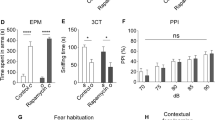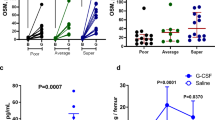Abstract
Lithium is commonly used in psychiatry for mood stabilization. Lithium treatment results in neutrophilia, increased platelets and increased circulating CD34+ haematopoietic stem cells, HSC. This paper outlines the newly discovered mechanism by which this occurs. Glycogen synthase kinase-3, GSK-3, phosphorylates and thereby inactivates hypoxia-induced factor-1, HIF-1. HIF-1 is a transcription factor triggering transcription of multiple genes related to adaptation to hypoxia, among which is CXCL12. CXCL12 forms the primary homing gradient for CD34+ HSCs towards the hypoxic, trophic bone marrow niche to which they must go to thrive. Lithium inhibits GSK-3 thereby increasing active HIF-1 that results in a stronger CXCL12 homing gradient. Trophic niche function is enhanced, ultimately resulting in increased production of neutrophils, platelets and CD34+ cells. Sitagliptin is a new drug to treat diabetes that coincidentally inhibits destruction of CXCL12. Thus, lithium and sitagliptin enhance CXCL12 by different paths, potentially increasing trophic niche function. Awareness of this path is important in HSC transplantation.
This is a preview of subscription content, access via your institution
Access options
Subscribe to this journal
Receive 12 print issues and online access
$259.00 per year
only $21.58 per issue
Buy this article
- Purchase on Springer Link
- Instant access to full article PDF
Prices may be subject to local taxes which are calculated during checkout

Similar content being viewed by others
References
Crossley NA, Bauer M . Acceleration and augmentation of antidepressants with lithium for depressive disorders: two meta-analyses of randomized, placebo-controlled trials. J Clin Psychiatry 2007; 68: 935–940.
Guzzetta F, Tondo L, Centorrino F, Baldessarini RJ . Lithium treatment reduces suicide risk in recurrent major depressive disorder. J Clin Psychiatry 2007; 68: 380–383.
Murphy DL, Goodwin FK, Bunney Jr WE . Leukocytosis during lithium treatment. Am J Psychiatry 1971; 127: 1559–1561.
Tisman G, Herbert V, Rosenblatt S . Evidence that lithium induces human granulocyte proliferation: elevated serum vitamin B 12 binding capacity in vivo and granulocyte colony proliferation in vitro. Br J Haematol 1973; 24: 767–771.
Joyce RA . Sequential effects of lithium on haematopoiesis. Br J Haematol 1984; 56: 307–321.
Canales MA, Arrieta R, Hernandez-Garcia C, Bustos JG, Aguado MJ, Hernandez-Navarro F . A single apheresis to achieve a high number of peripheral blood CD34+ cells in a lithium-treated patient with acute myeloid leukaemia. Bone Marrow Transplant 1999; 23: 305.
Ballin A, Lehman D, Sirota P, Litvinjuk U, Meytes D . Increased number of peripheral blood CD34+ cells in lithium-treated patients. Br J Haematol 1998; 100: 219–221.
Forde JE, Dale TC . Glycogen synthase kinase 3: a key regulator of cellular fate. Cell Mol Life Sci 2007; 64: 1930–1944.
Li X, Friedman AB, Zhu W, Wang L, Boswell S, May RS et al. Lithium regulates glycogen synthase kinase-3beta in human peripheral blood mononuclear cells: implication in the treatment of bipolar disorder. Biol Psychiatry 2007; 61: 216–222.
Shaltiel G, Chen G, Manji HK . Neurotrophic signaling cascades in the pathophysiology and treatment of bipolar disorder. Curr Opin Pharmacol 2007; 7: 22–26.
Flugel D, Gorlach A, Michiels C, Kietzmann T . Glycogen synthase kinase-3 phosphorylates hypoxia-inducible factor 1alpha and mediates its destabilization in a VHL-independent manner. Mol Cell Biol 2007; 27: 3253–3265.
Wiesener MS, Maxwell PH . HIF and oxygen sensing; as important to life as the air we breathe? Ann Med 2003; 35: 183–190.
Jensen RL, Ragel BT, Whang K, Gillespie D . Inhibition of hypoxia inducible factor-1alpha (HIF-1alpha) decreases vascular endothelial growth factor (VEGF) secretion and tumor growth in malignant gliomas. J Neurooncol 2006; 78: 233–247.
Parmar K, Mauch P, Vergilio JA, Sackstein R, Down JD . Distribution of hematopoietic stem cells in the bone marrow according to regional hypoxia. Proc Natl Acad Sci USA 2007; 104: 5431–5436.
Heissig B, Ohki Y, Sato Y, Rafii S, Werb Z, Hattori K . A role for niches in hematopoietic cell development. Hematology 2005; 10: 247–253.
Broxmeyer HE, Hangoc G, Cooper S, Campbell T, Ito S, Mantel C . AMD3100 and CD26 modulate mobilization, engraftment, and survival of hematopoietic stem and progenitor cells mediated by the SDF-1/CXCL12–CXCR4 axis. Ann N Y Acad Sci 2007; 1106: 1–19.
Sugiyama T, Kohara H, Noda M, Nagasawa T . Maintenance of the hematopoietic stem cell pool by CXCL12–CXCR4 chemokine signaling in bone marrow stromal cell niches. Immunity 2006; 25: 977–988.
Arya M, Ahmed H, Silhi N, Williamson M, Patel HR . Clinical importance and therapeutic implications of the pivotal CXCL12–CXCR4 (chemokine ligand–receptor) interaction in cancer cell migration. Tumour Biol 2007; 28: 123–131.
Zagzag D, Lukyanov Y, Lan L, Ali MA, Esencay M, Mendez O et al. Hypoxia-inducible factor 1 and VEGF upregulate CXCR4 in glioblastoma: implications for angiogenesis and glioma cell invasion. Lab Invest 2006; 86: 1221–1232.
Liu YL, Yu JM, Song XR, Wang XW, Xing LG, Gao BB . Regulation of the chemokine receptor CXCR4 and metastasis by hypoxia-inducible factor in non small cell lung cancer cell lines. Cancer Biol Ther 2006; 5: 1320–1326.
Tabatabai G, Frank B, Mohle R, Weller M, Wick W . Irradiation and hypoxia promote homing of haematopoietic progenitor cells towards gliomas by TGF-beta-dependent HIF-1alpha-mediated induction of CXCL12. Brain 2006; 129 (Part 9): 2426–2435.
Ceradini DJ, Kulkarni AR, Callaghan MJ, Tepper OM, Bastidas N, Kleinman ME et al. Progenitor cell trafficking is regulated by hypoxic gradients through HIF-1 induction of SDF-1. Nat Med 2004; 10: 858–864.
Dewhirst MW, Cao Y, Li CY, Moeller B . Exploring the role of HIF-1 in early angiogenesis and response to radiotherapy. Radiother Oncol 2007; 83: 249–255.
Fulda S, Debatin KM . HIF-1-regulated glucose metabolism: a key to apoptosis resistance? Cell Cycle 2007; 6: 790–792.
Luker KE, Luker GD . Functions of CXCL12 and CXCR4 in breast cancer. Cancer Lett 2006; 238: 30–41.
Pore N, Maity A . The chemokine receptor CXCR4: a homing device for hypoxic cancer cells? Cancer Biol Ther 2006; 5: 1563–1565.
Duke-Cohan JS, Morimoto C, Rocker JA, Schlossman SF . Serum high molecular weight dipeptidyl peptidase IV (CD26) is similar to a novel antigen DPPT-L released from activated T cells. J Immunol 1996; 156: 1714–1721.
Christopherson II KW, Uralil SE, Porecha NK, Zabriskie RC, Kidd SM, Ramin SM . G-CSF- and GM-CSF-induced upregulation of CD26 peptidase downregulates the functional chemotactic response of CD34+CD38− human cord blood hematopoietic cells. Exp Hematol 2006; 34: 1060–1068.
Christopherson II KW, Hangoc G, Mantel CR, Broxmeyer HE . Modulation of hematopoietic stem cell homing and engraftment by CD26. Science 2004; 305: 1000–1003.
Drucker DJ, Nauck MA . The incretin system: glucagon-like peptide-1 receptor agonists and dipeptidyl peptidase-4 inhibitors in type 2 diabetes. Lancet 2006; 368: 1696–1705.
Focosi D, Kast RE, Petrini M . Gliptins. Lancet 2007; 369: 269–270.
Author information
Authors and Affiliations
Corresponding author
Rights and permissions
About this article
Cite this article
Kast, R. How lithium treatment generates neutrophilia by enhancing phosphorylation of GSK-3, increasing HIF-1 levels and how this path is important during engraftment. Bone Marrow Transplant 41, 23–26 (2008). https://doi.org/10.1038/sj.bmt.1705872
Received:
Revised:
Accepted:
Published:
Issue Date:
DOI: https://doi.org/10.1038/sj.bmt.1705872
Keywords
This article is cited by
-
Pharmacological modulation of HIF-1 in the treatment of neuropsychiatric disorders
Journal of Neural Transmission (2023)
-
Effects of Nanosized Lithium Carbonate Particles on Intact Muscle Tissue and Tumor Growth
Bulletin of Experimental Biology and Medicine (2014)
-
GSK-3β: a signaling pathway node modulating neural stem cell and endothelial cell interactions
Angiogenesis (2011)



